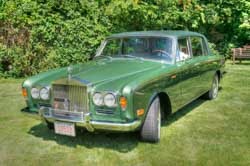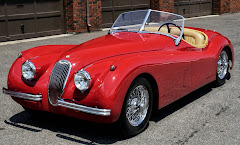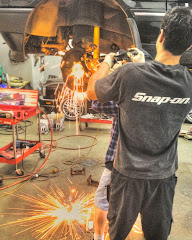Everyone loves the look of real wood in late model luxury cars. Some carmakers - like Cadillac - are changing from plastic to wood as quality of their cars rises. Others - like Bentley - have used real wood all along. Beautiful as it is real wood has one big drawback - cracks. The wood absorbs moisture from the air, and it shrinks and expands with changing temperatures. The wood and varnish move at different crates and cracks are inevitable unless the car is kept in a temperature and humidity stable room. Since that's not the reality for most cars, most cars have cracked woodwork by the time they turn ten. Often sooner.
These photos show what cracks look like on dashboards and door caps:
Subtle dash cracks may add character, or at least that's how people rationalize them because they don't want to spend money on repairs. Few owners think of door cap cracks like those above as character. They just look bad.
We encourage owners to fix damage like this as soon as it appears, because if it's ignored the result will be damaged veneers and hundreds of dollars in additional costs for each damaged panel. It's usually best to refinish all the door caps at the same time for visual consistency.
Bentley often put logos under the varnish on door capping. These decals are usually printed or etched on thin metal foil. Be careful as many decals are unavailable. We can reproduce them but costs can be significant. Varnish cracks admit air and moisture and that may damage decals.
We encourage owners to fix damage like this as soon as it appears, because if it's ignored the result will be damaged veneers and hundreds of dollars in additional costs for each damaged panel. It's usually best to refinish all the door caps at the same time for visual consistency.
Bentley often put logos under the varnish on door capping. These decals are usually printed or etched on thin metal foil. Be careful as many decals are unavailable. We can reproduce them but costs can be significant. Varnish cracks admit air and moisture and that may damage decals.
In the photo above you can see how the varnish has cracked through the cap. You can also see how the varnish has acquired a yellowish cast. The photo above is of a 2001 Bentley, and it was taken in spring 2018. This is typical of the cracking and yellowing you will see at this age.
The first step in repairing crack damage is removal of the pieces. The door caps on old RR/B cars are the size and heft of baseball bats. The photo below shows one of the caps removed. The writing on the back denotes the assembler, the last digits of the serial number the wood was destined for, and a position code.
This photo shows the markings on the back of a typical piece. Most times you will see the car's serial number on every piece. Occasionally you see cars where the numbers on the wood don't match. This may be from warranty repair. The factory always had a few pieces of wood available for warranty exchange and that allowed damaged pieces to be refinished and re-used on other cars.
Rolls-Royce used to take pride in how their veneers were matched at the factory. The photo below shows a dash from a 1991 Corniche where the rightmost piece of wood is a mismatch. This was not picked up by the car's first three owners over the first quarter-century of the car's life. The only way to make this perfect is to refinish all the dash pieces using continuous sheets of veneer.
That is just one of the stories woodwork has told us over the years. After removing the wood trim we photograph every piece. We note cracks (top photo) and remove all the brackets, felt pads, and other pieces. The positions of all these bits must be recorded because they are individual to the car. If they are mixed up the proper assembly of the car will be vastly complicated.
On older cars (pre-1990) the wood trim will consist of veneer bonded to hardwood or plywood substrate. Newer cars use laminates, often consisting of a backing like Luan mahogany, then a sheet of soft aluminum, and then a veneer with a clear coat finish on top. The multi-layer wood won't splinter or shatter in an accident. It's safer but less durable. It does have the advantage of being more easily formed into curves, and you can see that design freedom expressed in the voluptuous interior shapes of newer Bentley motorcars versus the more angular interior styling of the 1990s and backward.
This is a circa 2000 Seraph/Arnage dashboard, on the car and on the bench.
Once the wood is off the car and the trim is removed the next step will be to strip off the finish. Sometimes all you need is a new finish; other times you find the veneer and even the wood substrate damaged. Will Rau has written a number of articles on the wood repair and refinish steps.
We end up doing veneer repairs on perhaps 1/3 of the pieces we refinish. This is the time to consider new veneers and patterns. If the car in question is really exceptional we may be asked to make test pieces with different veneers and finishes to get the optimum choice. Just as finishes yellow with age they can be tinted from the start to achieve different effects. The images below show several combinations for a door cap on a coach built car from the 1970s.

When wood is refinished the yellow cast disappears. The new finish is richer and sharper. and the different really stands out in before and after images. The photos show dash panels from a 2001 Bentley Arnage Le Mans.
Each piece of wood will need to be refitted with the trim and hardware that were removed prior to refinishing. This is a painstaking process as shown below. We store the hardware for each piece in its own plastic bag so they don't get mixed up:
Newer Bentley or Rolls-Royce (and also many high end Mercedes, Maybach, etc) have complex assemblies with wood panels and wood doors that open. Often the panels have threaded machine screws holding things together and a lot of painstaking assembly is required. Tiny threads can get clogged with overspray from the refinishing and it's easy to break things if you're not careful. The series below shows a dash door on a 2001 Bentley:
Wood pieces often come off older cars in any order. There is often a specific order of assembly on newer cars. For example, in the Arnage/Seraph cars the air bag cover is the first piece to go in. It's retained by a line of 7 screws across the top. Once installed the dash top can be fastened down, and then the rest of the dash goes in. The center console goes together separately.
More often than not, in the exotic car world, there are no detailed workshop manuals. If manuals exist they are often incorrect or incomplete. A high degree of skill and patience are required.
As you can see it's a lot of work to take this stuff apart, and it can't be rushed. I cringe when I see dealer technicians tearing into the dashboards on newer Bentleys as they race to get stuff apart for the minimal rates warranty work pays. Once the pieces are assembled they can be fitted into the trim panels and then refitted to the car.
The result is well worth the effort and cost. There is no substitute for the look of real wood trim.
John Elder Robison
The first step in repairing crack damage is removal of the pieces. The door caps on old RR/B cars are the size and heft of baseball bats. The photo below shows one of the caps removed. The writing on the back denotes the assembler, the last digits of the serial number the wood was destined for, and a position code.
This photo shows the markings on the back of a typical piece. Most times you will see the car's serial number on every piece. Occasionally you see cars where the numbers on the wood don't match. This may be from warranty repair. The factory always had a few pieces of wood available for warranty exchange and that allowed damaged pieces to be refinished and re-used on other cars.
Rolls-Royce used to take pride in how their veneers were matched at the factory. The photo below shows a dash from a 1991 Corniche where the rightmost piece of wood is a mismatch. This was not picked up by the car's first three owners over the first quarter-century of the car's life. The only way to make this perfect is to refinish all the dash pieces using continuous sheets of veneer.
That is just one of the stories woodwork has told us over the years. After removing the wood trim we photograph every piece. We note cracks (top photo) and remove all the brackets, felt pads, and other pieces. The positions of all these bits must be recorded because they are individual to the car. If they are mixed up the proper assembly of the car will be vastly complicated.
On older cars (pre-1990) the wood trim will consist of veneer bonded to hardwood or plywood substrate. Newer cars use laminates, often consisting of a backing like Luan mahogany, then a sheet of soft aluminum, and then a veneer with a clear coat finish on top. The multi-layer wood won't splinter or shatter in an accident. It's safer but less durable. It does have the advantage of being more easily formed into curves, and you can see that design freedom expressed in the voluptuous interior shapes of newer Bentley motorcars versus the more angular interior styling of the 1990s and backward.
This is a circa 2000 Seraph/Arnage dashboard, on the car and on the bench.
Once the wood is off the car and the trim is removed the next step will be to strip off the finish. Sometimes all you need is a new finish; other times you find the veneer and even the wood substrate damaged. Will Rau has written a number of articles on the wood repair and refinish steps.
We end up doing veneer repairs on perhaps 1/3 of the pieces we refinish. This is the time to consider new veneers and patterns. If the car in question is really exceptional we may be asked to make test pieces with different veneers and finishes to get the optimum choice. Just as finishes yellow with age they can be tinted from the start to achieve different effects. The images below show several combinations for a door cap on a coach built car from the 1970s.

When wood is refinished the yellow cast disappears. The new finish is richer and sharper. and the different really stands out in before and after images. The photos show dash panels from a 2001 Bentley Arnage Le Mans.
Each piece of wood will need to be refitted with the trim and hardware that were removed prior to refinishing. This is a painstaking process as shown below. We store the hardware for each piece in its own plastic bag so they don't get mixed up:
Newer Bentley or Rolls-Royce (and also many high end Mercedes, Maybach, etc) have complex assemblies with wood panels and wood doors that open. Often the panels have threaded machine screws holding things together and a lot of painstaking assembly is required. Tiny threads can get clogged with overspray from the refinishing and it's easy to break things if you're not careful. The series below shows a dash door on a 2001 Bentley:
Wood pieces often come off older cars in any order. There is often a specific order of assembly on newer cars. For example, in the Arnage/Seraph cars the air bag cover is the first piece to go in. It's retained by a line of 7 screws across the top. Once installed the dash top can be fastened down, and then the rest of the dash goes in. The center console goes together separately.
More often than not, in the exotic car world, there are no detailed workshop manuals. If manuals exist they are often incorrect or incomplete. A high degree of skill and patience are required.
As you can see it's a lot of work to take this stuff apart, and it can't be rushed. I cringe when I see dealer technicians tearing into the dashboards on newer Bentleys as they race to get stuff apart for the minimal rates warranty work pays. Once the pieces are assembled they can be fitted into the trim panels and then refitted to the car.
The result is well worth the effort and cost. There is no substitute for the look of real wood trim.
(c) 2018 John Elder Robison
John Elder Robison is the general manager of J E Robison Service Company, celebrating 30 years of independent Bentley, BMW/MINI, Mercedes, Land Rover, and Rolls-Royce restoration and repair in Springfield, Massachusetts. John is a longtime technical consultant to the car clubs, and he’s owned and restored many fine British and German motorcars. Find him online at www.robisonservice.com or in the real world at 413-785-1665
Reading this article will make you smarter, especially when it comes to car stuff. So it's good for you. But don't take that too far - printing and eating it will probably make you sick.






























































2 comments:
Are there newer finishes available today that are more durable and UV-resistant (to prevent yellowing) than the finishes used on older cars? What about flexible finishes, that may move with the wood and resist cracking?
We do use modern finishes that are more flexible but there is still a limit. If the wood absorbs moisture it will damage the bond. The wood may expand beyond the limit of the finish. The only crack free wood is plastic wood. With all their modern engineering resources none of the carmakers have solved this on 10-year-old production cars either
Post a Comment